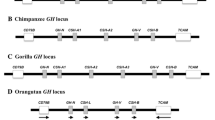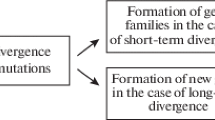Abstract
It has been demonstrated previously that in mammals the evolution of pituitary growth hormone shows an unusual pattern, with an underlying slow rate and at least two sustained bursts of rapid evolution (in the artiodactyls and primates), during which the rate increased at least 25-fold. It is demonstrated here that a similar pattern applies for growth hormone evolution throughout the vertebrates, with a basal rate similar to that seen in mammals, but bursts of rapid evolution in the amphibia and the elasmobranchs, and several bursts in the teleosts. The placental growth-hormone-like proteins of primates show a similar pattern. It is argued that the bursts of evolution seen for growth hormone are a consequence of selection and that this may reflect changes in the functions of the hormone additional to its basic growth-promoting actions.
Similar content being viewed by others
References
Agellon LB, Davies SL, Chen TT, Powers DA (1988) Structure of a fish (rainbow trout) growth hormone gene and its evolutionary implications. Proc Natl Acad Sci USA 85:5136–5140
Ascasio-Martinez JA, Barrera-Saldana HA (1994a) A dog growth hormone cDNA codes for a mature protein identical to pig growth hormone. Gene 134:277–280
Ascasio-Martinez JA, Barrera-Saldana HA (1994b) Sequence of a cDNA encoding horse growth hormone. Gene 143:299–300
Ber R, David V (1992) Structure and sequence of the growth hormoneencoding gene from Tilapia nilotica. Gene 113:245–250
Bernardi G, D'Onofrio G, Caccio S, Bernardi G (1993) Molecular phylogeny of bony fishes, based on the amino acid sequence of the growth hormone. J Mol Evol 37:644–649
Carroll RL (1988) Vertebrate paleontology and evolution. Freeman, New York
Castro-Peralta F, Barrera-Saldana HA (1995) Cloning and sequencing of cDNA encoding the cat growth hormone. Gene 160:311–312
Chen EY, Liao Y-C, Smith DH, Barrera-Saldana HA, Gelinas RE, Seeburg PH (1989) The human growth hormone locus: nucleotide sequence, biology, and evolution. Genomics 4:479–497
Chiou C-S, Chen H-T, Chang W-C (1990) The complete nucleotide sequence of the growth-hormone gene from the common carp (Cyprinus carpio). Biochim Biophys Acta 1087:91–94
Dayhoff MO (1972) Atlas of protein sequence of structure, vol 5. National Biomedical Research Foundation, Washington, DC
Farmer SW, Papkoff H (1979) Comparative biochemistry of pituitary growth hormone, prolactin and the glycoprotein hormones. In: Barrington EJW (ed) Hormones and evolution, vol 2. Academic Press, New York, pp 525–559
Felsenstein J (1993) PHYLIP (Phylogeny Inference Package) version 3.5c. Distributed by the author. Department of Genetics, University of Washington, Seattle
Fitch WM, Margoliash E (1967) Construction of phylogenetic trees. Science 155:279–284
Gillespie JH (1991) The causes of molecular evolution. Oxford University Press, New York
Golos TG, Dunning M, Fisher JM, Fowler PD (1993) Cloning of four GH/chorionic somatomammotropin-related cDNAs differentially expressed during pregnancy in the rhesus monkey placenta. Endocrinology 133:1744–1752
Kawauchi H, Yasuda A (1989) Evolutionary aspects of growth hormone from nonmammalian species. In: Muller EE, Cocchi D, Locatelli V (eds) Advances in growth hormone research. Pythagora Press, Rome, pp 51–68
Kimura M (1983) The neutral theory of molecular evolution. Cambridge University Press, Cambridge
Maddison WP, Maddison DR (1992) MacClade: analysis of phylogeny and character evolution, version 3.0. Sinauer, Sunderland, MA
Mouchiroud D, Gautier C, Bernardi G (1995) Frequencies of synonymous substitutions in mammals are gene specific and correlated with frequencies of nonsynonymous substitutions. J Mol Evol 40:107–113
Nei M, Gojobori T (1986) Simple methods for estimating the numbers of synonymous and nonsynonymous nucleotide substitutions. Mol Biol Evol 3:418–426
Noso T, Lance VA, Kawauchi H (1995) Complete amino acid sequence of crocodile growth hormone. Gen Comp Endocrinol 98:244–252
Ohta T (1993) Pattern of nucleotide substitutions in growth hormoneprolactin gene family: a paradigm for evolution by gene duplication. Genetics 134:1271–1276
Romer AS (1986) Vertebrate paleontology. University of Chicago Press, Chicago
Rubin DA, Dores RM (1995) Obtaining a more resolute teleost growth hormone phylogeny by the introduction of gaps in sequence alignment. Mol Phylogenet Evol 4:129–138
Tanaka M, Hosokawa Y, Watahiki M, Nakashima K (1992) Structure of the chicken growth hormone-encoding gene and its promoter region. Gene 112:235–239
Wallis M (1981) The molecular evolution of pituitary growth hormone, prolactin and placental lactogen: a protein family showing variable rates of evolution. J Mol Evol 17:10–18
Wallis M (1988) Mechanism of action of growth hormone. In: Cooke BA, King RJB, van den Molen HJ (eds) Hormones and their actions, part II (New comprehensive biochemistry, vol 18B). Elsevier, Amsterdam, pp 265–294
Wallis M (1992) The expanding growth hormone/prolactin family. J Mol Endocrinol 9:185–188
Wallis M (1993) Remarkably high rate of molecular evolution of ruminant placental lactogens. J Mol Evol 37:86–88
Wallis M (1994) Variable evolutionary rates in the molecular evolution of mammalian growth hormones. J Mol Evol 38:619–627
Wallis OC, Wallis M (1995) Cloning and characterisation of the rabbit growth hormone-encoding gene. Gene 163:253–256
Author information
Authors and Affiliations
Rights and permissions
About this article
Cite this article
Wallis, M. The molecular evolution of vertebrate growth hormones: A pattern of near-stasis interrupted by sustained bursts of rapid change. J Mol Evol 43, 93–100 (1996). https://doi.org/10.1007/BF02337353
Received:
Accepted:
Issue Date:
DOI: https://doi.org/10.1007/BF02337353




